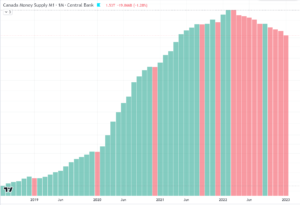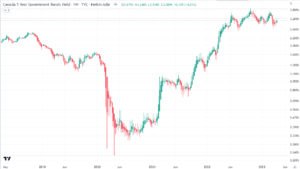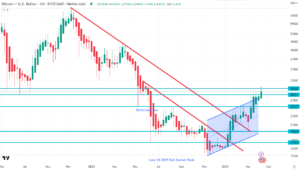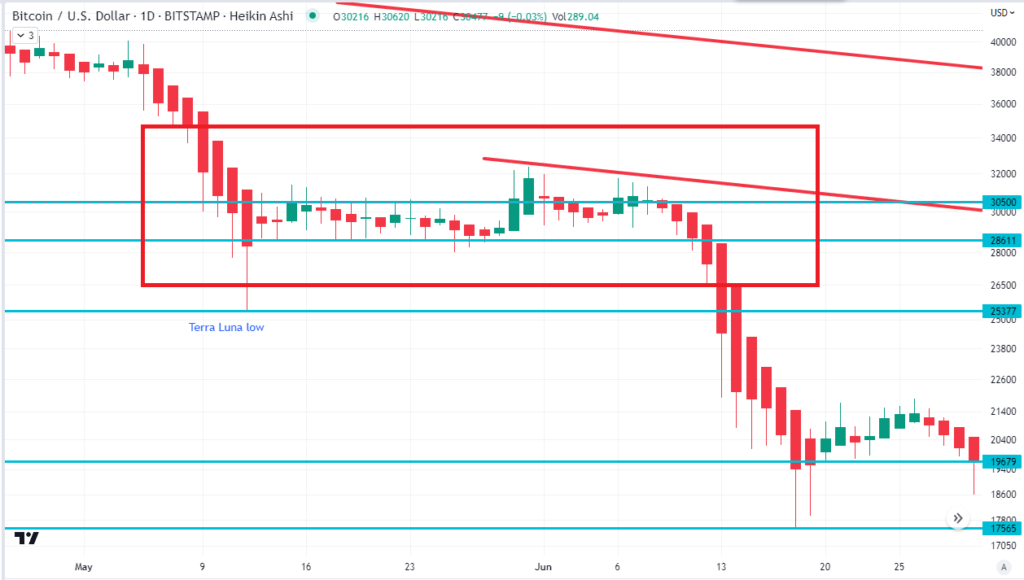My thesis for 2023 is simple: the economy is heading into a recession (or is already in a recession), and therefore, “risk on” assets (stocks and Bitcoin) will go down, and “risk off” assets (bonds) will go up.
So far this year, my thesis has not played out as expected.
Am I wrong, or early?
Let’s think about it.

The M1 money supply in Canada has fallen in ten of the last 11 months.
When was the last time that happened?
Never.
There was a period in 1988 when M1 fell in seven months of a ten-month period, but that’s it.
The government, all governments, printed a massive amount of money in 2020 and 2021, but starting in March 2022, the great deleveraging began, and M1 is down over 7% since then.
M2 and M3 continue to increase but are significantly slower than in 2020 and 2021. If there is less money out there, there is less money chasing stocks and crypto, so it is logical to assume they will not increase at the same rate or drop.
 The Canadian 5 Year Bond yield, which collapsed to close to zero in 2020, peaked at just under 4% in October 2022 and now sits at 3.24%. That’s lower than a month ago but considerably higher than two years ago.
The Canadian 5 Year Bond yield, which collapsed to close to zero in 2020, peaked at just under 4% in October 2022 and now sits at 3.24%. That’s lower than a month ago but considerably higher than two years ago.
The Fed, and the Bank of Canada, want to fight inflation, and the only tool they have at their disposal is interest rates, so it’s not surprising that for the last year, their strategy has been hike, hike, hike.
But the massive increase in interest rates will kill the economy. A higher cost of borrowing leads to less borrowing, leading to reduced spending, leading to a recession.
In the lead up to a recession, stocks don’t go up.
The key to this thought process is timing. Stocks are a leading indicator. Investors are betting on what will happen, not what has happened.
The S&P 500 is almost 15% lower today than it was in January, 2022. Why? Because investors are not optimistic about the future.
But the timing of the recession, and subsequent recovery, is uncertain. Will the Fed raise again? Will they pause? Or pivot? We don’t know, so we are in that uncertain period where we await their next decision.
This brings us to the remarkable rise of Bitcoin.

Since its bottom in November 2022, Bitcoin has almost doubled.
Bitcoin has broken through two significant down trend channels. As I write this early Saturday morning on April 15, Bitoinc is trading at around $30,500 USD, above the psychologically (but not technically) important level of $30,000.
So what’s next?
I don’t know. I didn’t expect Bitcoin to return to $30,000 this quickly.
It will note that $30,500 is a more significant resistance level than $30,000.
Here’s the chart of Bitcoin from May 2022, just over a year ago:

As you can see, Bitcoin danced around the $30,500 level for five weeks, ultimately couldn’t hold it, and collapsed to below $20,000.
Could that happen again?
Yes.
It would not surprise me to see that the Big Boyz let Bitcoin rise above $30,000 so that the retail trade thinks, “the bull market is back!” and that’s where they lay on the shorts and run it back down.
My guess is that that’s what will happen, both with Bitcoin and the stock market.
I expect lower prices over the summer.
Sell in May (or April) and go away.
So that’s how I’m playing.
I don’t own Bitcoin.
I’m long bonds, and the only stocks I own are solid companies that should do well in a recession.
I also hold cash.
We shall see if that strategy is correct or completely wrong.
Stay tuned.
Bitcoin and Bonds
by JDH on April 15, 2023
My thesis for 2023 is simple: the economy is heading into a recession (or is already in a recession), and therefore, “risk on” assets (stocks and Bitcoin) will go down, and “risk off” assets (bonds) will go up.
So far this year, my thesis has not played out as expected.
Am I wrong, or early?
Let’s think about it.
The M1 money supply in Canada has fallen in ten of the last 11 months.
When was the last time that happened?
Never.
There was a period in 1988 when M1 fell in seven months of a ten-month period, but that’s it.
The government, all governments, printed a massive amount of money in 2020 and 2021, but starting in March 2022, the great deleveraging began, and M1 is down over 7% since then.
M2 and M3 continue to increase but are significantly slower than in 2020 and 2021. If there is less money out there, there is less money chasing stocks and crypto, so it is logical to assume they will not increase at the same rate or drop.
The Fed, and the Bank of Canada, want to fight inflation, and the only tool they have at their disposal is interest rates, so it’s not surprising that for the last year, their strategy has been hike, hike, hike.
But the massive increase in interest rates will kill the economy. A higher cost of borrowing leads to less borrowing, leading to reduced spending, leading to a recession.
In the lead up to a recession, stocks don’t go up.
The key to this thought process is timing. Stocks are a leading indicator. Investors are betting on what will happen, not what has happened.
The S&P 500 is almost 15% lower today than it was in January, 2022. Why? Because investors are not optimistic about the future.
But the timing of the recession, and subsequent recovery, is uncertain. Will the Fed raise again? Will they pause? Or pivot? We don’t know, so we are in that uncertain period where we await their next decision.
This brings us to the remarkable rise of Bitcoin.
Since its bottom in November 2022, Bitcoin has almost doubled.
Bitcoin has broken through two significant down trend channels. As I write this early Saturday morning on April 15, Bitoinc is trading at around $30,500 USD, above the psychologically (but not technically) important level of $30,000.
So what’s next?
I don’t know. I didn’t expect Bitcoin to return to $30,000 this quickly.
It will note that $30,500 is a more significant resistance level than $30,000.
Here’s the chart of Bitcoin from May 2022, just over a year ago:
As you can see, Bitcoin danced around the $30,500 level for five weeks, ultimately couldn’t hold it, and collapsed to below $20,000.
Could that happen again?
Yes.
It would not surprise me to see that the Big Boyz let Bitcoin rise above $30,000 so that the retail trade thinks, “the bull market is back!” and that’s where they lay on the shorts and run it back down.
My guess is that that’s what will happen, both with Bitcoin and the stock market.
I expect lower prices over the summer.
Sell in May (or April) and go away.
So that’s how I’m playing.
I don’t own Bitcoin.
I’m long bonds, and the only stocks I own are solid companies that should do well in a recession.
I also hold cash.
We shall see if that strategy is correct or completely wrong.
Stay tuned.